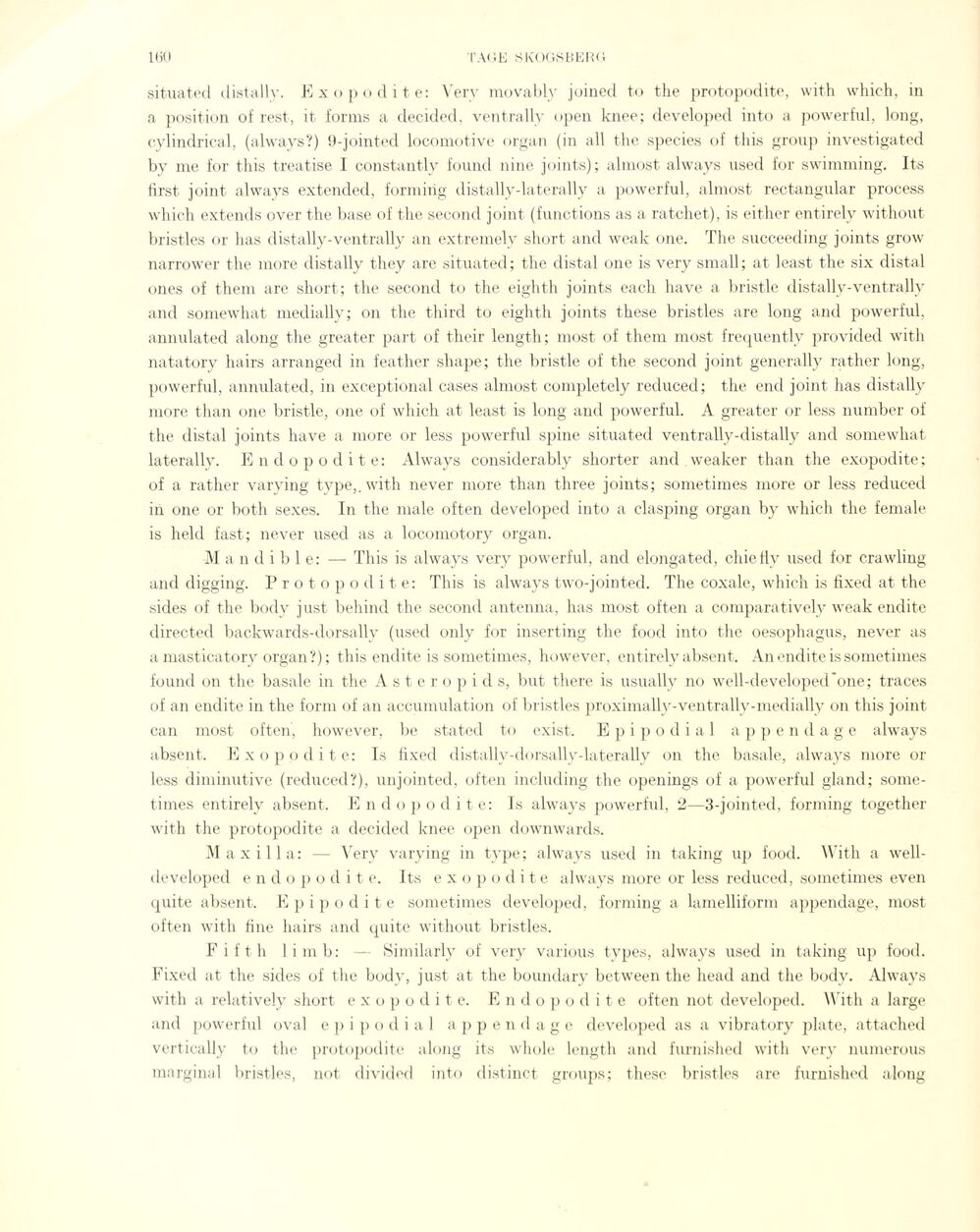
Full resolution (JPEG) - On this page / på denna sida - Sidor ...

<< prev. page << föreg. sida << >> nästa sida >> next page >>
Below is the raw OCR text
from the above scanned image.
Do you see an error? Proofread the page now!
Här nedan syns maskintolkade texten från faksimilbilden ovan.
Ser du något fel? Korrekturläs sidan nu!
This page has never been proofread. / Denna sida har aldrig korrekturlästs.
situated distally. Ex o pod i t e: Very movably joined to the protopodite, with which, in
a position of rest, it forms a decided, ventrally open knee; developed into a powerful, long,
cylindrical, (always?) 9-jointed locomotive organ (in all the species of this group investigated
by me for this treatise I constantlv found nine joints); almost always used for swimming. Its
first joint always extended, forming distally-laterally a powerful, almost rectangular process
which extends over the base of the second joint (functions as a ratchet), is either entirely without
bristles or lias distally-ventrally an extremely short and weak one. The succeeding joints grow
narrower the more distally they are situated; the distal one is very small; at least the six distal
ones of them are short; the second to the eighth joints each have a bristle distally-ventrally
and somewhat medially; on the third to eighth joints these bristles are long and powerful,
annula ted along the gréa ter part of their length; most of them most frequently provided with
natatory hairs arranged in feather shape; the bristle of the second joint generally rather long,
powerful, annulated, in exceptional cases almost completely reduced; the end joint lias distally
more than one bristle, one of which at least is long and powerful. A greater or less number of
the distal joints have a more or less powerful spine situated ventrally-distally and somewhat
laterally. En dopod ite: Always considerably shorter and weaker than the exopodite ;
of a rat lier varying type,, with never more than three joints; sometimes more or less reduced
in one or both sexes. In the male often developed into a clasping organ by which the female
is held fast; never used as a locomotory organ.
M a n d i b 1 e: — This is always very powerful, and elongated, ehiefly used for crawling
and digging. Protopodite: This is always two-jointed. The coxale, which is fixed at the
sides of the body just behind the second antenna, has most often a comparatively weak endite
directed backwards-dorsally (used only for inserting the food into the oesophagus, never as
a mastica tory organ?) ; this endite is sometimes, however, entirely absent. An endite is sometimes
found on the basale in the Asteropids, but there is usually no well-developed’one; traces
of an endite in the form of an accumulation of bristles proximally-ventrally-medially on this joint
can most often, however, be stated to exist. Epipodial appendage always
absent. Exopodite: Is fixed distally-dorsally-laterally on the basale, always more or
less diminutive (reduced?), unjointed, often including the openings of a powerful gland;
sometimes entirely absent. Endop odite: Is always powerful, 2—3-jointed, forming together
with the protopodite a decided knee open downwards.
Maxilla: — Very varying in type; always used in taking up food. With a
well-developed e n d o p o d i t e. Its exopodite always more or less reduced, sometimes even
quite absent. E p i p odite sometimes developed, forming a lamelliform appendage, most
often with fine hairs and quite without bristles.
Fifth limb: — Similarly of very various types, always used in taking up food.
Fixed at the sides of the body, just at the boundary between the head and the body. Always
with a relatively short exopodite. Endopodite often not developed. With a large
and powerful oval epipodial appendage developed as a vibratory plate, attached
vertically to the protopodite along its whole length and furnished with very numerous
marginal bristles, not divided into distinct groups; these bristles are furnished along
<< prev. page << föreg. sida << >> nästa sida >> next page >>